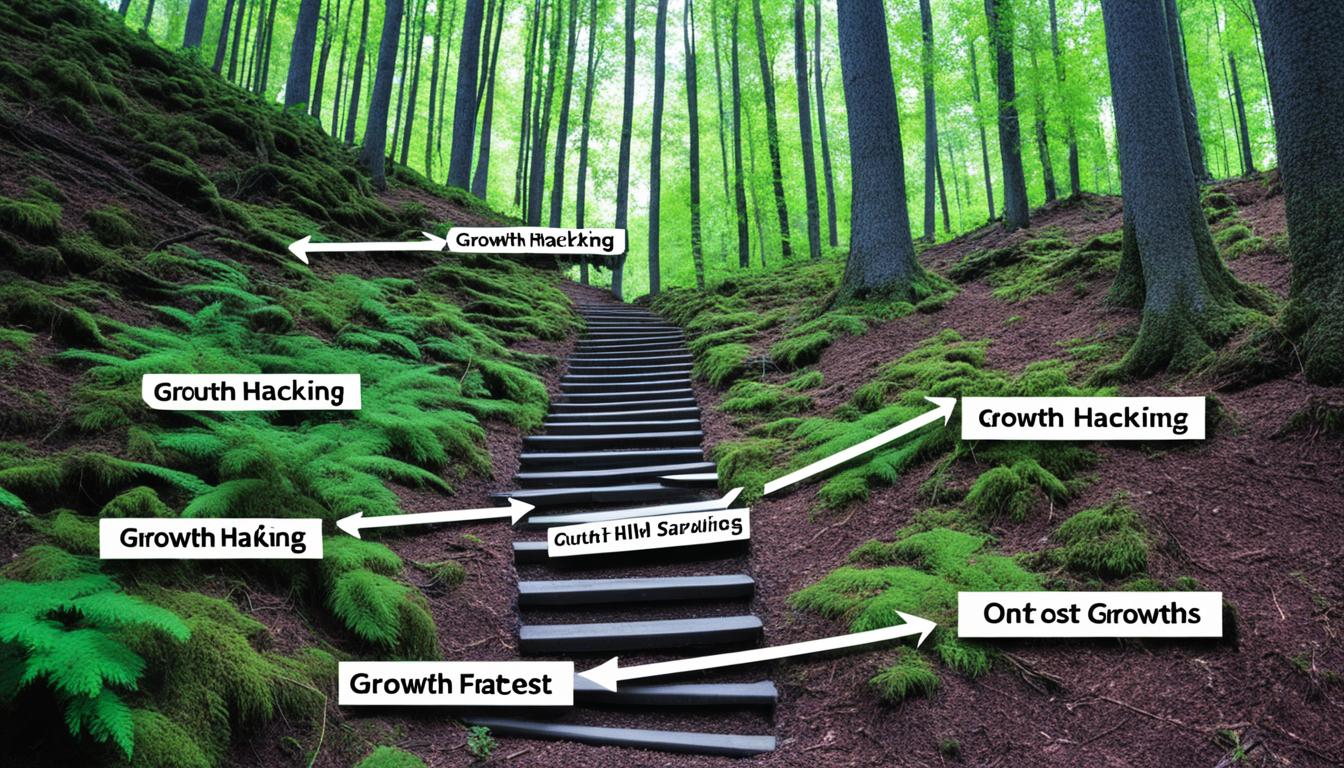A Bachelor’s in Business Administration (BBA) in Marketing focuses on marketing basics and tactics in the business realm. It teaches students how to analyze market trends and create promotional efforts. This includes learning about advertising, market research, and online marketing strategies.
Those who finish a BBA in Marketing can look into careers in multiple fields. This includes jobs in marketing and sales, market research, and managing brands. They can also dive into the world of digital marketing.
Key Takeaways:
- A BBA in Marketing provides students with a solid foundation in marketing principles and strategies.
- The program covers various aspects of marketing, including advertising, market research, branding, and digital marketing.
- Graduates can pursue careers in marketing and sales, market research, brand management, and digital marketing.
- A BBA in Marketing opens up opportunities in various career fields.
- Marketing is a dynamic and ever-evolving field that offers exciting and rewarding career prospects.
What Is Marketing?
Marketing is all about connecting the right products and services to the right people. It helps businesses grow by promoting what they offer. Through advertising, branding, market research, and more, it aims to make people aware, interested, and ready to buy.
It targets specific groups, whether everyday people or other companies. Good marketing shows off a product’s or service’s special qualities. It uses what we know about what people like and want. This way, it grabs the attention of those likely to buy.
Different ways are used to spread the word about offerings. These can be old-school methods like magazines, TV, radio, and billboards. Or, they can be digital, like using the internet, emails, and social media. Which methods to use depends on who the business wants to reach and what it aims to achieve.
Understanding Marketing
Marketing involves actions a company takes to draw in and keep customers. It includes more than just promoting products and services. It’s about creating and keeping good relationships with customers.
Its main goal is to match what a company offers with what its customers want. By knowing what customers like and how they act, companies can create value and be profitable. This needs looking into market trends and customer data to spot growth chances and make strategies that boost customer involvement and loyalty.
Networking is key in marketing. It helps businesses make connections with other professionals and potential customers. These connections can lead to useful collaborations, referrals, and opening up new markets. All this helps a company grow and succeed.
Having good relationships with customers is crucial for a business’s long-term success. Good customer relationship management (CRM) means communicating in a personal way and using marketing strategies that fit each customer’s needs. By doing this, businesses can build loyalty and get repeat business, which leads to more profit.
Benefit of Customer-Centric Marketing
Customer-centric marketing strategies bring several benefits to businesses. By focusing on what customers need and want, companies can:
- Attract and retain loyal customers
- Increase customer satisfaction and loyalty
- Enhance brand reputation and trust
- Drive customer advocacy and referrals
- Identify new market opportunities
- Improve profitability through repeat business
Focusing on customers can give businesses an edge over their competitors. It helps them stand out.
| Marketing Actions | Impact on Profitability |
|---|---|
| Networking | Expanding customer base, accessing new markets |
| Customer Relationship Management | Repeat business, customer loyalty |
| Personalized Communication | Improved customer satisfaction, increased sales |
| Market Research and Analysis | Identifying market trends, targeting high-demand products or services |
The 4 Ps of Marketing
For effective marketing, businesses need to understand the 4 Ps. They are product, price, place, and promotion. These help businesses achieve their goals.
Product
A key part of marketing is the product. It’s what a business offers its customers. Knowing its features, benefits, and what makes it special is crucial. This way, a business can position it uniquely against competitors.
Price
Setting the right price is vital for marketing success. It must reflect the value to customers and ensure profit. Production costs, competition, and customer expectations all play a part in this. The goal is to find a price that customers perceive as good value.
Place
“Place” means where customers can buy the product. It’s about choosing the right ways to reach them. This could be in a store or online. The choice should consider convenience, accessibility, and how the target market prefers to shop.
Promotion
Promotion involves telling people about the product. It uses advertising, public relations, and more. The aim is to build awareness and convince people to buy. Crafting effective promotions can lead to increased sales.
Using the 4 Ps thoughtfully allows businesses to craft strong marketing strategies. Each component plays a role in offering a comprehensive approach. Below is a brief overview of the 4 Ps:
| Marketing Mix | Description |
|---|---|
| Product | The goods or services offered by the business |
| Price | The cost associated with the product or service |
| Place | The location or channel where customers can access the product |
| Promotion | The marketing activities used to communicate and promote the product |
Understanding the 4 Ps can help businesses reach their customers more effectively. It enables them to stand out, offer great value, and be profitable.
Traditional vs. Digital Marketing Strategies
In the marketing world, companies have many ways to spread the word about what they sell. There are traditional and digital marketing routes.
Traditional Marketing
Traditional marketing is about old-school methods that have been around for years. Methods include:
- Television and radio advertisements
- Print media such as newspapers and magazines
- Outdoor advertising like billboards and banners
- Direct mail campaigns
These traditional ways can reach a lot of people and make a brand known. But they often cost a lot and don’t let you choose your audience well.
Digital Marketing
Digital marketing uses tech and internet to connect with buyers. It includes:
- Digital advertising through platforms like Google Ads and social media ads
- Social media marketing on platforms like Facebook, Instagram, and Twitter
- Search engine marketing, including search engine optimization (SEO) and pay-per-click (PPC) advertising
- Email marketing campaigns
- Affiliate marketing, where businesses collaborate with influencers or affiliates to promote their products or services
- Content marketing, which involves creating and sharing valuable content to attract and retain customers
This form of marketing lets businesses target specific groups, track success, and change tactics easily. It’s more cost-effective and offers a direct way to engage with customers.
https://www.youtube.com/watch?v=5A4D5xnrtIA
| Traditional Marketing | Digital Marketing |
|---|---|
| Reaches a broad audience | Allows precise audience targeting |
| High costs, limited control over messaging | Cost-effective, real-time optimization |
| Offline reach and visibility | Online reach and interaction |
| Difficult to measure campaign success | Trackable and measurable results |
Now, many businesses use both traditional and digital marketing. This strategy ensures wide visibility, better engagement, and higher ROI. Knowing the pros and cons of both allows marketers to create effective campaigns.
Benefits of Marketing
Marketing brings many benefits for business growth and success. With strong marketing strategies, businesses can enjoy advantages such as:
Audience Generation
Marketing expands your business’s reach to more people. It uses targeted ads and promotions to raise visibility. This draws in those interested in what you offer.
Inward Education
Marketing gives insights into your target market. Through research and analytics, you learn about customer likes and habits. This knowledge helps tailor your offerings to meet customer needs.
Outward Education
Marketing educates people about your business’s products, services, and brand. By showcasing what makes you unique, you build awareness and trust. This makes customers more likely to choose you.
Brand Creation
Good marketing helps create a strong brand identity. This sets you apart from competitors and gains customer loyalty. A strong brand means trust and credibility, making customers prefer your product or service.
| Benefits of Marketing |
|---|
| Audience Generation |
| Inward Education |
| Outward Education |
| Brand Creation |
Types of Marketing Strategies
Marketing strategies are key for promoting products or services and reaching company goals. Companies choose different marketing strategies based on their specific needs and objectives.
1. Outdoor Marketing
Outdoor marketing uses physical spaces and outdoor ads to connect with people. It includes billboards, bus shelters, vehicle wraps, and signs at events or trade shows. This method is great for catching the eye of passersby and spreading brand awareness.
2. Print Marketing
Print marketing means advertising through print materials like newspapers and magazines. Also, it includes brochures, flyers, and direct mail. This traditional way is great for local businesses to reach certain areas or groups.
3. Direct Marketing
Direct marketing reaches potential customers directly through things like direct mail, calls, and email marketing. It aims to send personalized messages to spark interest and increase sales.
4. Electronic Marketing
Electronic marketing includes digital ads like display ads, video ads, and search engine ads. It uses online places to promote things and talk to the target audience. It brings together search engine marketing, email marketing, social media marketing, and affiliate marketing.
5. Event Marketing
Event marketing is about hosting or backing events to promote something. It lets businesses meet potential customers and make lasting memories. Event marketing can be small local events or big conferences or trade shows.
6. Search Engine Marketing
Search engine marketing (SEM) is about getting more visibility in search engine results through paid ads. This includes paid search ads (PPC) and using SEO to get better organic search rankings.
7. Social Media Marketing
Social media marketing uses platforms like Facebook and Instagram to connect with people. It’s about making and sharing content, running targeted ads, and engaging with users. This strategy builds brand awareness and drives traffic or conversions.
8. Content Marketing
Content marketing focuses on making and sharing valuable content to attract and keep a specific audience. It offers useful information, solves issues, and gains trust, leading to profitable customer actions.
| Marketing Strategy | Description |
|---|---|
| Outdoor Marketing | Utilizes physical spaces and outdoor advertising mediums to reach a wide audience. |
| Print Marketing | Advertising through printed materials such as newspapers, magazines, and brochures. |
| Direct Marketing | Reaching out to potential customers through direct mail, telemarketing, and email marketing. |
| Electronic Marketing | Digital advertising through online platforms, including search engine, email, social media, and affiliate marketing. |
| Event Marketing | Organizing or sponsoring events to promote a brand, product, or service. |
| Search Engine Marketing | Increasing visibility in search engine results pages through paid advertising campaigns. |
| Social Media Marketing | Engaging with the target audience through social media platforms to build brand awareness and drive conversions. |
| Content Marketing | Creating and distributing valuable content to attract and retain a clearly defined audience. |
An Example of a Marketing Plan
A marketing plan is a detailed guide showing how a company intends to market itself. It lays out strategies, action plans, and budgets. This plan also has ways to handle unexpected changes.
Situation Analysis
The situation analysis looks at the market right now. It spots both opportunities and challenges. For the Spree watch, it found a rising interest in stylish yet affordable tech wearables.
Objectives
The goals for the Spree watch’s marketing are to:
- Increase brand awareness and recognition
- Target and attract tech-savvy millennials
- Generate buzz and excitement around the product launch
- Drive sales and achieve a 10% market share within the first year
Marketing Strategies
Here are the marketing moves for the Spree watch:
- Building a strong online presence through social media and influencer partnerships
- Teaming up with fitness influencers to highlight the watch’s health features
- Launching digital ads on top tech and fashion sites
- Organizing launch events in major cities
Action Plan
Our action plan lists the steps to take to achieve our marketing goals. This includes:
- Designing a user-friendly website and online store
- Creating exciting social media content and posting often
- Working with influencers and having product giveaways
- Putting together launch events
Financial Analysis
This part talks about the costs and expected profits of our marketing actions. It covers setting budgets, predicting income, and analyzing profits.
Contingency Plans
Contingency plans are our backup strategies for unexpected market changes. They keep our marketing flexible and ready for anything.
Spree – The Market Plan
The Spree watch market plan looks at the market and its customers deeply. It’s about finding the best ways to introduce and sell the Spree watch. This plan covers financial goals and backup plans for success.
Situation Analysis
We’re investigating the current market situation. Here, we look into trends, what customers like, and what competitors are doing. This gives us insights into the Spree watch’s opportunities and challenges.
Market Analysis
Our market analysis focuses on who will likely buy the Spree watch. We figure out what these customers want. This helps us aim our marketing to attract and connect with them.
Consumer Behavior
It’s critical to understand why our customers buy things. By exploring their needs and how they decide on purchases, we can match our Spree watch to what they’re searching for.
Competitive Analysis
This part looks at our rivals’ strengths and weaknesses. It helps us see where we can shine and where we need to be different to catch the eye.
Company Analysis
In the company analysis, we check what the Spree watch team can do best. We use a SWOT analysis to see our strong points and what we need to watch out for.
Strategies and Tactics
This section talks about our plans and actions to make the Spree watch a hit. We outline how we’ll position the product, set prices, sell it, and get the word out.
Financial Projections
Here, we predict the money we’ll make and spend. It’s about seeing if our launch can bring in profits. Plus, it helps us make smart money choices.
Contingency Plans
We also have backup plans. These help us stay on track if things don’t go as expected. It’s about quickly adapting to whatever comes our way.
The goal of our market plan is to make sure the Spree watch shines in a busy market. By smart analysis and understanding our customers, we’re setting up for success.
| Market Analysis | Consumer Behavior | Competitive Analysis | Company Analysis |
|---|---|---|---|
| Identify target market segments | Analyze customer needs and preferences | Evaluate strengths and weaknesses of competitors | Assess company’s SWOT analysis |
| Understand market trends | Study consumer motivations | Identify potential market gaps | Identify internal strengths and weaknesses |
| Assess market size and growth potential | Examine purchasing patterns | Analyze competitor strategies | Identify external opportunities and threats |
Conclusion
A BBA in Marketing gives students a strong base in marketing principles and strategies. They learn how to create effective marketing strategies and analyze market trends. It also helps them understand what consumers want.
The Spree watch example shows these strategies at work in the real world. It talks about how businesses figure out who might buy their product and why. By learning about the market and competitors, they can make better marketing plans.
With a BBA in Marketing, there are many job paths you can take. Jobs in marketing management, brand management, market research, and digital marketing are all options. Marketing skills are more important than ever in today’s business world. This means graduates are in high demand. They’re ready to launch powerful marketing campaigns, study consumer trends, and create standout brands.



